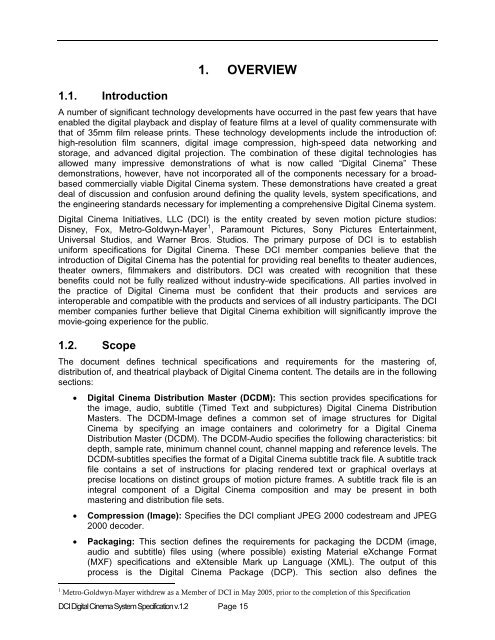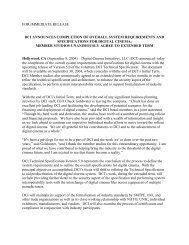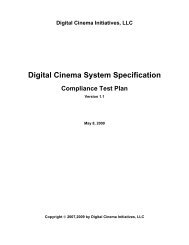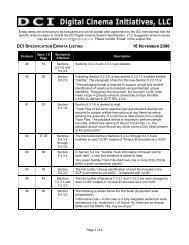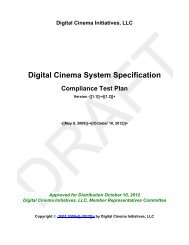DCI Specs - Digital Cinema Initiatives
DCI Specs - Digital Cinema Initiatives
DCI Specs - Digital Cinema Initiatives
Create successful ePaper yourself
Turn your PDF publications into a flip-book with our unique Google optimized e-Paper software.
1.1. Introduction1. OVERVIEWA number of significant technology developments have occurred in the past few years that haveenabled the digital playback and display of feature films at a level of quality commensurate withthat of 35mm film release prints. These technology developments include the introduction of:high-resolution film scanners, digital image compression, high-speed data networking andstorage, and advanced digital projection. The combination of these digital technologies hasallowed many impressive demonstrations of what is now called “<strong>Digital</strong> <strong>Cinema</strong>” Thesedemonstrations, however, have not incorporated all of the components necessary for a broadbasedcommercially viable <strong>Digital</strong> <strong>Cinema</strong> system. These demonstrations have created a greatdeal of discussion and confusion around defining the quality levels, system specifications, andthe engineering standards necessary for implementing a comprehensive <strong>Digital</strong> <strong>Cinema</strong> system.<strong>Digital</strong> <strong>Cinema</strong> <strong>Initiatives</strong>, LLC (<strong>DCI</strong>) is the entity created by seven motion picture studios:Disney, Fox, Metro-Goldwyn-Mayer 1 , Paramount Pictures, Sony Pictures Entertainment,Universal Studios, and Warner Bros. Studios. The primary purpose of <strong>DCI</strong> is to establishuniform specifications for <strong>Digital</strong> <strong>Cinema</strong>. These <strong>DCI</strong> member companies believe that theintroduction of <strong>Digital</strong> <strong>Cinema</strong> has the potential for providing real benefits to theater audiences,theater owners, filmmakers and distributors. <strong>DCI</strong> was created with recognition that thesebenefits could not be fully realized without industry-wide specifications. All parties involved inthe practice of <strong>Digital</strong> <strong>Cinema</strong> must be confident that their products and services areinteroperable and compatible with the products and services of all industry participants. The <strong>DCI</strong>member companies further believe that <strong>Digital</strong> <strong>Cinema</strong> exhibition will significantly improve themovie-going experience for the public.1.2. ScopeThe document defines technical specifications and requirements for the mastering of,distribution of, and theatrical playback of <strong>Digital</strong> <strong>Cinema</strong> content. The details are in the followingsections:• <strong>Digital</strong> <strong>Cinema</strong> Distribution Master (DCDM): This section provides specifications forthe image, audio, subtitle (Timed Text and subpictures) <strong>Digital</strong> <strong>Cinema</strong> DistributionMasters. The DCDM-Image defines a common set of image structures for <strong>Digital</strong><strong>Cinema</strong> by specifying an image containers and colorimetry for a <strong>Digital</strong> <strong>Cinema</strong>Distribution Master (DCDM). The DCDM-Audio specifies the following characteristics: bitdepth, sample rate, minimum channel count, channel mapping and reference levels. TheDCDM-subtitles specifies the format of a <strong>Digital</strong> <strong>Cinema</strong> subtitle track file. A subtitle trackfile contains a set of instructions for placing rendered text or graphical overlays atprecise locations on distinct groups of motion picture frames. A subtitle track file is anintegral component of a <strong>Digital</strong> <strong>Cinema</strong> composition and may be present in bothmastering and distribution file sets.• Compression (Image): Specifies the <strong>DCI</strong> compliant JPEG 2000 codestream and JPEG2000 decoder.• Packaging: This section defines the requirements for packaging the DCDM (image,audio and subtitle) files using (where possible) existing Material eXchange Format(MXF) specifications and eXtensible Mark up Language (XML). The output of thisprocess is the <strong>Digital</strong> <strong>Cinema</strong> Package (DCP). This section also defines the1 Metro-Goldwyn-Mayer withdrew as a Member of <strong>DCI</strong> in May 2005, prior to the completion of this Specification<strong>DCI</strong> <strong>Digital</strong> <strong>Cinema</strong> System Specification v.1.2 Page 15


